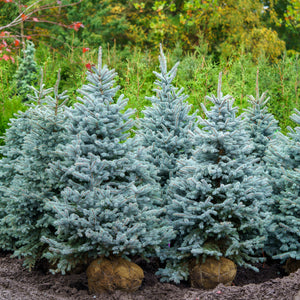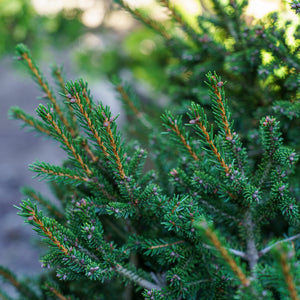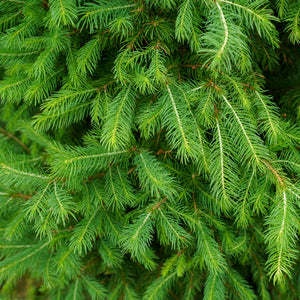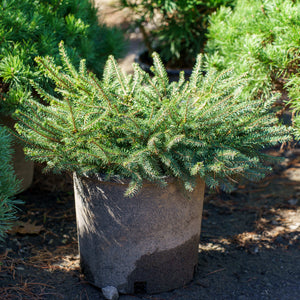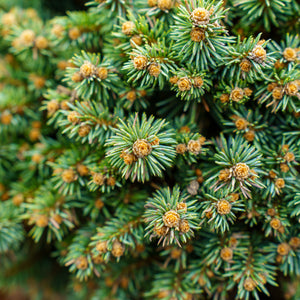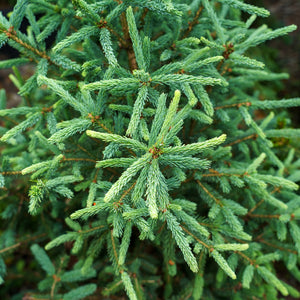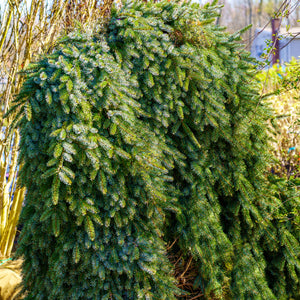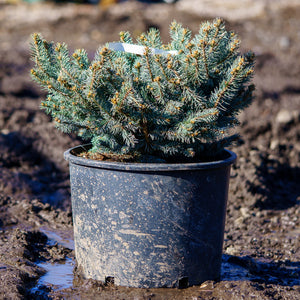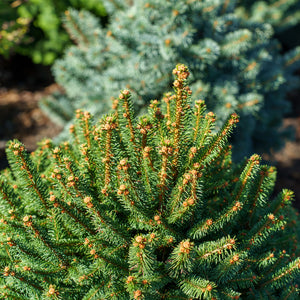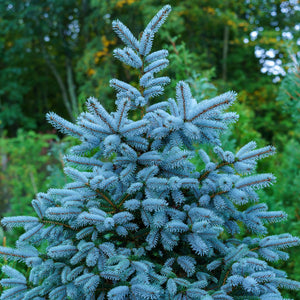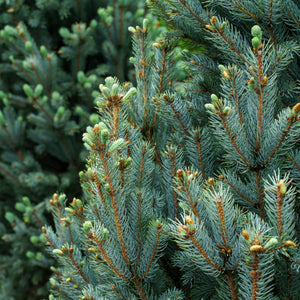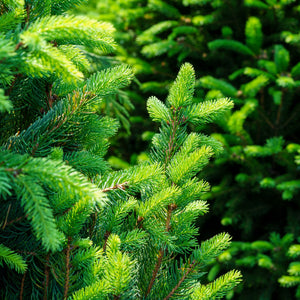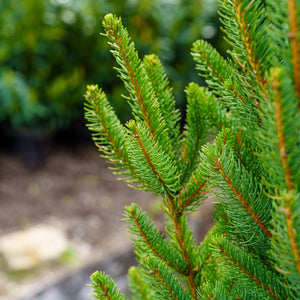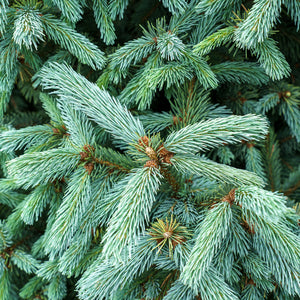The Spruce Guide
Spruce trees bring a majestic and resilient presence to any landscape. With their towering height, unique conical shape, and evergreen foliage, spruce trees command attention and bestow a sense of elegance upon gardens and outdoor spaces. These remarkable trees are renowned for their adaptability and ability to thrive in various climates and soil conditions with proper care and maintenance. Whether you seek a tranquil forest retreat or a striking focal point for your garden, spruce trees are an excellent choice that will leave a lasting impression. With their enduring beauty and unwavering presence, spruce trees add a touch of splendor to any landscape and serve as a symbol of strength and resilience in the natural world.
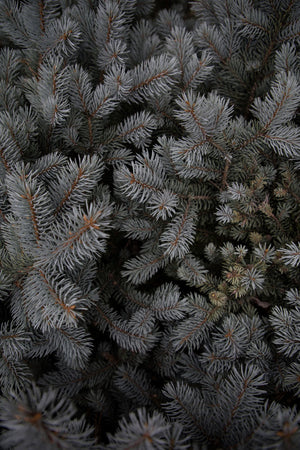
About
Spruce trees, belonging to the Picea genus, are a diverse group of evergreen coniferous trees that command attention and hold ecological significance. With various recognized species, spruce trees can be found across the temperate and boreal regions of the Northern Hemisphere, including North America, Europe, and Asia. These magnificent trees are characterized by their distinctive features and vital role in supporting local ecosystems. One of the defining characteristics of spruce trees is their iconic conical shape, with branches sweeping upwards and needles that remain green throughout the year, providing year-round beauty and structure.
The needles of spruce trees are typically short and sharp, arranged individually along the branches, adding texture and depth to their appearance. They come in a range of shades, from dark green to bluish-green or silver, depending on the species. Spruce trees are known for their resilience and adaptability, able to thrive in a variety of soil types and climates. They can withstand cold temperatures, strong winds, and even tolerate some shade, making them a versatile choice for different landscapes.
Ecologically, spruce trees play a crucial role in supporting wildlife. Their dense foliage provides excellent shelter and nesting sites for birds, while their seeds serve as a vital food source for many small mammals. Additionally, spruce trees contribute to the overall health of the ecosystem by stabilizing soil, preventing erosion, and purifying the air by absorbing carbon dioxide and releasing oxygen.
Whether used as a majestic centerpiece in a garden, planted in rows to create a windbreak, or incorporated into mixed evergreen borders, spruce trees add a sense of grandeur and natural beauty to any landscape. Popular species of spruce trees include the Norway Spruce (Picea abies), recognized for its rapid growth and dense foliage, and the Blue Spruce (Picea pungens), prized for its striking blue-green needles. By carefully selecting and nurturing spruce trees in your landscape, you not only enhance the aesthetic appeal but also contribute to the preservation of these remarkable trees and the ecological balance they support.
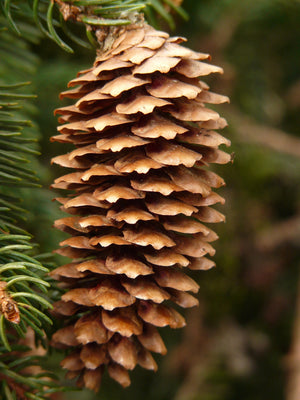
Planting
Spruce trees have specific planting requirements to ensure their successful establishment and growth. Here are some general guidelines for planting and caring for spruce trees:
Soil: Spruce trees thrive in well-drained soil that is slightly acidic to neutral. They prefer soil with a pH between 5.5 and 7.5. Before planting, prepare the site by loosening the soil and removing any weeds or grass. Incorporate organic matter, such as compost or peat moss, to improve soil structure and drainage.
Sunlight: Spruce trees generally prefer full sun to partial shade. Choose a location that receives at least six hours of direct sunlight each day. However, some spruce species, like the Colorado Blue Spruce (Picea pungens), can tolerate partial shade.
Watering: Adequate watering is essential for the initial establishment of spruce trees. After planting, water the tree deeply and thoroughly. Provide regular irrigation throughout the first year, especially during dry periods, to ensure the roots have sufficient moisture. Water deeply once or twice a week, allowing the soil to dry slightly between waterings.
Mulching: Apply a layer of organic mulch around the base of your spruce tree to conserve moisture, regulate soil temperature, and suppress weed growth. Use wood chips, bark, or compost as mulch, ensuring it is spread evenly around the tree. Keep the mulch a few inches away from the trunk to prevent excess moisture buildup and potential rotting.
Pruning: Spruce trees typically require minimal pruning. Remove any dead, damaged, or crossing branches to maintain a healthy and balanced structure. Prune during late winter or early spring while the tree is still dormant, before new growth begins. Use clean and sharp pruning tools to make precise cuts and minimize the risk of introducing infections.
By following these basic planting and care guidelines, you can ensure the successful establishment and healthy growth of your spruce trees. With proper care, your spruce trees will thrive and bring year-round beauty and evergreen charm to your landscape.
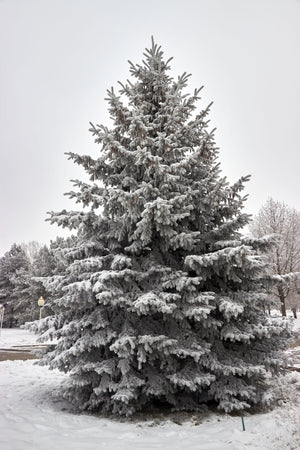
Care
Spruce trees require specific care to ensure their optimal growth and health. Here are some general guidelines for the care of spruce trees:
Watering: Provide regular watering to your spruce trees during the growing season. Aim to keep the soil consistently moist but not waterlogged. Deep watering is essential to encourage deep root growth. During dry periods or in high temperatures, additional watering may be necessary to prevent the soil from drying out.
Pruning: Pruning requirements for spruce trees are generally minimal. However, it's advisable to remove any dead, damaged, or diseased branches to maintain the tree's overall health and appearance. Prune during late winter or early spring before new growth emerges. Use clean and sharp pruning tools to make precise cuts and minimize the risk of introducing infections.
Fertilizing: Fertilizing can promote healthy growth and vigor in spruce trees. Apply a balanced, slow-release fertilizer specifically formulated for evergreen trees in the spring or early summer. Follow the recommended application rates and timing provided by the manufacturer. Avoid over-fertilizing, as it can lead to excessive foliage growth and weak branches. If unsure, it's best to err on the side of using less fertilizer.
Soil and Sunlight: Spruce trees thrive in well-drained soil that is slightly acidic to neutral. They can adapt to various soil types, but good drainage is crucial for their optimal growth. Provide full sun to partial shade for spruce trees. They generally prefer full sun but can tolerate some shade, especially in hot and dry climates.
Mulching: Apply a layer of organic mulch around the base of your spruce tree to conserve moisture, suppress weed growth, and regulate soil temperature. Use wood chips, bark, or compost as mulch, keeping it a few inches away from the trunk to prevent excess moisture buildup and potential rotting.
Pests and Diseases: Spruce trees are generally resistant to pests and diseases. However, it's important to monitor for common issues such as aphids, spider mites, or fungal diseases like needle cast. Regularly inspect your tree for any signs of damage or disease and take appropriate measures if needed. Pruning away affected branches and maintaining overall tree health can help prevent and manage pest and disease issues.
By following these basic care guidelines, your spruce trees will thrive, providing year-round beauty, shade, and a serene presence in your garden or landscape for years to come.
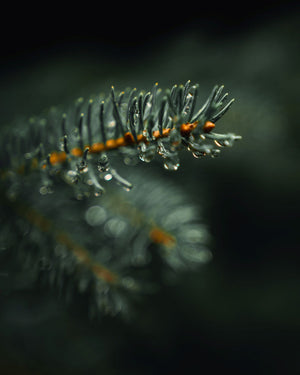
How To Use
Spruce trees offer versatility and can be used in various ways to enhance your landscape. Here are some recommendations based on their characteristics:
Privacy Screen: Spruce trees are dense and evergreen, making them ideal for creating a natural privacy screen in your landscape. Plant them in a row along your property line to establish an attractive and effective barrier that enhances privacy and adds visual appeal. The dense foliage of spruce trees provides year-round coverage and creates a secluded and tranquil environment.
Windbreak: Due to their sturdy growth and dense branches, spruce trees are excellent for creating a natural windbreak. Plant them in a row to create a windbreak that shields your garden, home, or outdoor living spaces from strong winds. The thick foliage of spruce trees acts as a barrier, reducing wind velocity and protecting delicate plants and structures.
Focal Point: Spruce trees can serve as striking focal points in your landscape. Their tall and pyramid-shaped forms, along with their vibrant green foliage, draw attention and add a sense of grandeur to your garden. Plant a single spruce tree in a prominent location to create a captivating centerpiece that commands attention and becomes a visual anchor for your outdoor space.
Screening and Framing: Use spruce trees to frame and highlight specific areas of your landscape. Plant them strategically to frame views, mark entrances, or guide the eye toward architectural features or focal points. The vertical lines and dense foliage of spruce trees create structure and define spaces within your garden.
Winter Interest: Spruce trees offer year-round visual interest, especially during winter. Their evergreen foliage provides a splash of green in an otherwise barren landscape, creating a lively and inviting atmosphere. The ability of spruce trees to retain their needles throughout the year adds texture and color, making them a valuable addition to winter gardens.
When selecting spruce trees for your landscape, consider their specific growth habits and environmental requirements. Ensure they are planted in areas that provide adequate sunlight and well-drained soil. With their versatility and striking features, spruce trees bring beauty, privacy, and resilience to your outdoor environment.
Conclusion
Spruce trees are a captivating and versatile addition to any landscape. With their dense foliage, towering presence, and remarkable resilience, spruce trees are highly valued for their beauty and practical benefits. By following proper planting and care practices, you can unlock the full potential of spruce trees to transform your outdoor space into a captivating retreat. Whether you desire a natural privacy screen, a windbreak, or a striking focal point, spruce trees can fulfill various roles in your landscape. Planting a row of spruce trees along your property line creates a visual barrier that enhances privacy and shields against strong winds. Their tall and pyramid-shaped forms make them ideal as focal points that command attention and create a sense of grandeur. The evergreen foliage of spruce trees adds year-round color and texture to your garden, bringing life and vibrancy even in the depths of winter. Spruce trees also provide a habitat for wildlife, attracting birds and other creatures with their dense branches and protective shelter. With their captivating beauty, functional benefits, and ability to thrive in diverse environments, spruce trees bring enduring joy and a touch of natural elegance to your outdoor environment.

